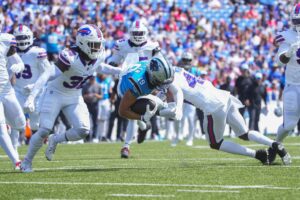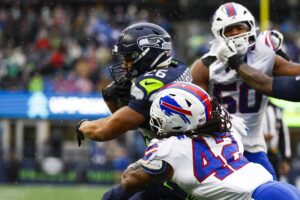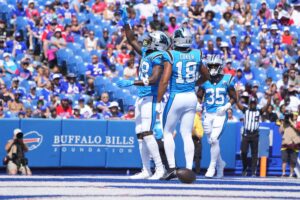Lonnie Phelps NFL Draft Overview
Position: Edge Defender
Height: 6′-2″
Weight: 244 pounds
School: Kansas
2023 NFL Draft: Lonnie Phelps Scouting Report
After spending his college years between Kansas and Miami (OH), Lonnie Phelps has declared for the 2023 NFL Draft. During his lone season with the Jayhawks, the edge defender recorded 57 tackles, 11.5 tackles-for-loss, and seven sacks, proving that he’s capable of performing well against higher levels of competition.
Lonnie Phelps originally began his college football journey back in 2019. Seeing the field as a true freshman, the Ohio native finished his inaugural campaign with 19 tackles, five tackles-for-loss, and four sacks. While he only played in two games in 2020, he came back stronger than ever in 2021. Appearing in 11 games, the edge defender recorded 30 tackles, 13.5 tackles-for-loss, and 8.5 sacks before transferring to Kansas.
Strengths
- Understands leverage to push tackles around;
- Above-average athlete with untapped talent;
- Fantastic endurance – rushes just as hard in the fourth quarter as he does in the first;
- Fast off the snap with good bend;
- Never gives up till the whistle blows – chases down run plays with regularity;
- Good special teams player.
Weaknesses
- Very rough around the edges – fundamentals need some work;
- Small for the position – 10th percentile arm length, 6th percentile weight, 15th percentile height;
- Struggles to set an anchor against the run – can be pushed around;
- Rarely wins with raw strength alone – if a tackle takes away his leverage, he’s out of the play;
- Not very versatile.
NFL Comparison: Elvis Dumervil
Teams With Need at Position: Arizona Cardinals, Baltimore Ravens, Carolina Panthers, Cleveland Browns, Detroit Lions, Kansas City Chiefs, Los Angeles Rams, New Orleans Saints, Seattle Seahawks
Projection: Rounds 5-6
Bottom Line on Lonnie Phelps
Through the first three years of his college football career, Lonnie Phelps was a good player taking advantage of poor competition. However, now that he proved he can handle high-level collegiate talent, Phelps has earned the right to compete for a spot on an NFL roster. Any team drafting him is primarily doing so because of his relentless motor and speed off the snap. Phelps’ quick reaction time and above-average bend ability lets him fly past offensive tackles, and he can keep his balance even when somebody gets a hand on him.
Additionally, Phelps’ aggression isn’t limited to just the pass game. He’ll never stop pursuing the ball carrier until the whistle is blown, and it’s not uncommon to see him travel from one side of the field to the other in relentless pursuit of the ball carrier.
This aggression can be a double-edged sword, however. You can tell that Phelps just wants to bring the pain on every single snap, and sometimes he gets so excited that he starts to lose focus on his fundamentals. This is coachable, but what isn’t coachable is his small build. The edge defender is incredibly small for his position, and while he carries a decent amount of strength, he could still use more muscle if he ever wants to start. While his small build can make it easier for him to get leverage, when a tackle counters that, Phelps basically has nothing left to do but wait until the play is over.
Ultiamtely, Lonnie Phelps should be a perfect situational pass rusher, at least early in his career. His lack of upside will keep him from being a Day 2 pick, but don’t be surprised if he racks up a few sacks as a rookie. At the very least, he should be able to earn a roster spot as a core special teams player.
Main Photo: Kirby Lee – USA Today Sports






